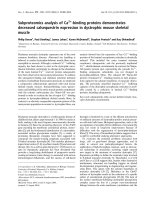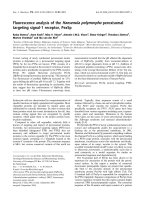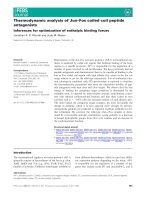báo cáo khoa học: " High-throughput analysis of chromosome translocations and other genome rearrangements in epithelial cancers" pdf
Bạn đang xem bản rút gọn của tài liệu. Xem và tải ngay bản đầy đủ của tài liệu tại đây (293.27 KB, 4 trang )
Introduction
Somatic structural variations in the genome - referred to
by cytogeneticists as translocations, inversions, duplica-
tions and insertions - can be powerful events in tumor
evolution because they can create fusion genes. Fusion
genes are formed when part of one gene is juxtaposed to
another by a structural rearrangement, creating a hybrid
transcript, or sometimes simply inserting a novel promo-
ter upstream of a gene. ese can be very powerful
oncogenic mutations, not only increasing expression of a
protein but also changing its activity, subcellular localiza-
tion or binding specificity [1,2]. Such fusion genes are
also clinically important, because some can predict
outcome and determine management, and some may be
targets for therapy [1]. For example, the BCR-ABL fusion
gene defines a group of leukemias and is the target of
treatment with the kinase inhibitor Glivec.
In stark contrast to leukemias, lymphomas and
sarcomas, in which many important oncogenes have
been identified at translocation breaks, we have a poor
understanding of how structural variations contribute to
carcinogenesis in common epithelial tumors [1,2].
Although we have relatively good knowledge of which
genes can be point-mutated, amplified or deleted in these
cancers, the sheer number and complexity of their
genome rearrangements has made it difficult to identify
genes at chromosome breakpoints [2]. We have known
for several years that recurrent gene fusions are found in
common epithelial cancers, following the discovery of
the TMPRSS2-ERG and related fusions in prostate cancer
[3] and EML4-ALK in lung cancer [4]. However, these
fusions were discovered by essentially one-off methods
and it remains to be seen whether these are isolated
examples or the tip of an iceberg.
Stephens et al. [5] recently presented the first large-
scale survey of somatically acquired structural variation
in the genomes of cancers, with the explicit goal of
discovering genes disrupted and fused at chromosome
breakpoints. e authors [5] used massively parallel
paired end sequencing to find genome rearrangements in
24 breast cancers - 9 of which were from immortal cell
lines and 15 from primary tumors. Although these data
pertain to breast cancer, we think many of the findings
will also be relevant to other common cancers, and
certainly they are consistent with a preceding pilot study
of two lung cancer cell lines [6]. e Stephens et al. [5]
study revealed that structural variants contribute
significantly to the mutational burden of many breast
cancers, but also that genes are often fused or otherwise
disrupted by mechanisms we have, so far, not appreciated.
Massively parallel paired end sequencing
Massively parallel sequencing techniques generate very
large numbers of sequence reads, but the reads are
generally much shorter than in traditional sequencing,
typically only tens of base pairs. To use these short
sequence ‘tags’ efficiently to find structural rearrange-
ments, ‘paired end read’ strategies have been developed
Abstract
Genes that are broken or fused by structural changes
to the genome are an important class of mutation in
the leukemias and sarcomas but have been largely
overlooked in the common epithelial cancers. Large-
scale sequencing is changing our perceptions of
the cancer genome, and it is now being applied to
structural changes, using the ‘paired end’ strategy. This
reveals more clearly than before the extent to which
many cancer genomes are rearranged and how much
these rearrangements contribute to the mutational
burden of epithelial tumors. In particular, there are
probably many fusion genes, analogous to those found
in leukemias, to be found in common cancers, such as
breast carcinoma, and some of these will prove to be
important in cancer diagnosis and treatment.
© 2010 BioMed Central Ltd
High-throughput analysis of chromosome
translocations and other genome rearrangements
in epithelial cancers
Scott Newman* and Paul AW Edwards*
M I NI R E V IE W
*Correspondence: ;
Hutchison-MRC Research Centre and Department of Pathology, University of
Cambridge, Hills Road, Cambridge, CB2 0XZ, UK
Newman and Edwards Genome Medicine 2010, 2:19
/>© 2010 BioMed Central Ltd
(also known as ‘mate pair’ and ‘end sequence profiling’
strategies; Figure 1) [6]. e genome is broken into DNA
fragments of selected size, for example 500 base pairs
(bp) [5], and a short sequence, for example 37 bp, is read
from each end of each DNA fragment to give paired
sequences. Most of the fragments are normal, and their
paired reads map back to the reference genome about
500 bp apart and in the correct orientation. Structural
variants are discovered when read-pairs map
unexpectedly, for example to two different chromosomes
(translocation), too far apart (deletion), or in the wrong
orientation (tandem duplication or inversion) (Figure 1).
Considerable bioinformatic processing is required to
interpret the huge volume of sequence data, but millions
of paired reads are pruned down to a hundred or so
structural variants per tumor, most of which can be
confirmed by PCR.
Stephens et al. [5] estimate that 50% of structural
variations were detected in their study. is may seem
like a low figure but, as the authors showed, it was
sufficient to identify hundreds of structural variants and
tens of fusion genes. e main reason for missing
structural variants was that the amount of sequencing
was not enough to sample all rearrangements. Also,
breakpoints flanked by repeats may have been missed
because reads from repetitive regions are currently
discarded. We expect the proportion of structural
variants detected to increase in the future as more
sequencing reads are generated, the reads used are
longer, and bioinformatic analysis is refined.
Rearrangements in breast cancers are more
numerous than expected
ere were many more structural variants than most in
the field would have anticipated [5]. For cell lines, the
median number of rearrangements per sample was 101
and ranged from 58 to 245. For the tumors, the median
was 38 and ranged from 1 to 231. Approximately 85%
were intrachromosomal and less than 2 Mb [5], which
explains why earlier molecular cytogenetic approaches,
such as spectral karyotyping, array comparative genomic
hybridization (CGH) and array painting [7], under esti-
mated the number of rearrangements. ese aberrations
would not have been visible in metaphase chromosomes
and many were copy-number neutral or too small to have
shown up in most array CGH experiments.
Many fusion genes were predicted and several
were expressed
Many of the structural changes that Stephens et al. [5]
found juxtaposed the coding regions of two genes. An
important observation, extending earlier studies [2,7,8],
was that some breast cancers can express several fused
genes. Stephens et al. [5] showed that 21 novel fusion
genes were expressed and in frame so potentially
produced a functional fusion protein. Allowing for the
estimated 50% detection rate, this would equate to two
functional fusion genes per case. Most of the fusion genes
were of unknown function but several involved known or
likely cancer genes, such as ETV6, which is a known
target of translocations and encodes a member of the
oncogenic Ets transcription factor family, and EHF,
which also encodes an Ets family member. Some genes
seemed to be rearranged in several of the 24 samples but
no recurrent gene fusions were identified by fluorescence
in situ hybridization (FISH) or RT-PCR in a larger second
set of tumors [5]. is may simply be a reflection of the
heterogeneity of breast cancer - the samples used were
chosen to represent a range of different tumor subtypes -
or it may be that aberrant expression of an important 3’
gene can be driven by several different 5’ fusion transcript
partners, as happens, for example, to the Ets-related gene
ERG in prostate cancers.
Figure 1. Mapping structural variants using the paired end read
strategy. (a) A region of genome containing a translocation junction
between two dierent chromosomes (red and blue). (b) The entire
genome is fragmented, and fragments of a desired size, typically
500 bp, are selected. (c) The ends of the fragments are sequenced
for a small fraction of the fragment length, typically 35 bp (black
arrows). The Stephens et al. [5] study used 500 bp fragments and
37 bp sequencing reads but other combinations are possible. For
variations, see [2]. (d) The paired sequence tags are mapped back to
the reference genome. Most pairs map back about 500 bp from each
other on the same chromosome, but (e) the read pair spanning the
translocation breakpoint maps back to two dierent chromosomes in
the reference genome.
(a) A region with a translocation junction
(b) The whole genome is fragmented and fragments of
a given size selected
(c) Sequence is generated from the ends of each fragment
(d) Read pairs are aligned to the reference genome
(e) Most pairs map normally but structural variants map
unexpectedly
Newman and Edwards Genome Medicine 2010, 2:19
/>Page 2 of 4
Unanticipated classes of structural variation
An unexpected finding [5] was a number of somatically
acquired tandem duplications, a kind of structural change
that has rarely been detected until recently but is interesting
because it can lead to gene fusion [9]. A tandem duplication
occurs when a small region from 3kb to greater than 1 Mb
is duplicated, usually in a head-to-tail orientation. Some
tumors showed a distinctly higher number of tandem
duplications than the others, which led the authors [5] to
suggest that they were generated by a specific repair defect.
e BRCA1 and BRCA2 mutant tumors had fewer tandem
duplications than average, so the aberrant mechanism was
probably not related to these pathways.
e second surprising finding [5] was that many small
tandem duplications, inversions and deletions were
entirely within genes. In many cases this affected the exon
structure at the transcript level and novel isoforms were
observed. Some of these rearrangements were in putative
oncogenes, such as the transcription-factor-encoding gene
RUNX1, so it is plausible that oncogenic activation could
have occurred by removing or reshuffling exons that
encode a repressive protein domain. Well-characterized
tumor suppressor genes such as the retinoblastoma gene
RB also had internal rearrangements and it is possible
these genes were inactivated through frame shift in the
transcript or by removing important protein domains.
Two questions arise from these observations [5]: firstly,
whether the roles of genes such as RUNX1 and RB have
been underestimated in breast cancer, because these
kinds of mutation would not be detected by Sanger
sequencing studies on individual coding exons; and
secondly, whether there are numerous small rearrange-
ments of this kind in other, karyotypically normal, cancers.
Drivers and passengers?
It is remarkable how many mutations, whether sequence-
level, epigenetic or structural, are now being discovered in
cancer genomes [5,10,11]. Many are probably ‘passenger’
mutations, that is, random mutational noise, but some must
be selected, ‘driver’ events and, as the number and variety of
known mutations increases, estimates for the number of
‘driving’ mutations in cancer are tending to increase [2,12].
e problem of distinguishing driver and passenger
mutations is as acute for structural mutations as it is for
point mutations [10-13]. Stephens et al. [5] estimate that
approximately 2% of genome rearrangements of the types
they found would generate an in-frame fusion gene by
chance. ey observed 1.6%, which suggests that the
majority of gene fusions, like the majority of point
mutations, are not selected events.
Conclusions
e Stephens et al. [5] study is the first indication that
genome-wide structural analysis of a relatively large
number of samples, including primary tumors, is already
an achievable goal. More importantly, it illustrates that
such studies are worthwhile as they can create a large
yield of new candidate oncogenes and tumor suppressor
genes.
Clearly, the next step is to find genes or gene families
that are recurrently fused or rearranged in a subset of
tumors. anks to the methodologies and bioinformatic
tools already validated by pilot studies [5,6] we can expect
large surveys of several cancer types to appear within 2 or
3 years. is will allow us to address the question of
recurrence and move on to establish the clinical relevance
and potential for targeted intervention.
For the time being, massively parallel paired end
sequencing will remain a research tool, but the basic cost
of an analysis like that of Stephens et al. [5] is already
down to a few thousands of euros per case, so it is
conceivable that we will see it used in the clinic in the not
too distant future. Indeed, while this article was in press,
Velculescu and colleagues [14] announced a possible
clinical application, using paired end reads to find a
structural ‘fingerprint’ of a tumor that could be detected
in the patient’s serum and so used to monitor
progression.
Abbreviations
bp, base pair; CGH, comparative genomic hybridization.
Competing interests
The authors declare that they have no competing interests.
Authors’ contributions
SN drafted the article; SN and PE edited and approved the manuscript.
Acknowledgements
SN is supported by the UK Medical Research Council.
Author information
SN is a graduate student and PE is university faculty in the Hutchison-MRC
Research Centre and Department of Pathology, University of Cambridge, UK.
Published: 17 March 2010
References
1. Mitelman F, Johansson B, Mertens F: The impact of translocations and gene
fusions on cancer causation. Nat Rev Cancer 2007, 7:233-245.
2. Edwards PAW: Fusion genes and chromosome translocations in the
common epithelial cancers. J Pathol 2010, 220:244-254.
3. Tomlins SA, Rhodes DR, Perner S, Dhanasekaran SM, Mehra R, Sun XW,
Varambally S, Cao X, Tchinda J, Kuefer R, Lee C, Montie JE, Shah RB, Pienta KJ,
Rubin MA, Chinnaiyan AM: Recurrent fusion of TMPRSS2 and ETS
transcription factor genes in prostate cancer. Science 2005, 310:644-648.
4. Soda M, Choi YL, Enomoto M, Takada S, Yamashita Y, Ishikawa S, Fujiwara S,
Watanabe H, Kurashina K, Hatanaka H, Bando M, Ohno S, Ishikawa Y,
Aburatani H, Niki T, Sohara Y, Sugiyama Y, Mano H: Identification of the
transforming EML4-ALK fusion gene in non-small-cell lung cancer. Nature
2007, 448:561-566.
5. Stephens PJ, McBride DJ, Lin ML, Varela I, Pleasance ED, Simpson JT, Stebbings
LA, Leroy C, Edkins S, Mudie LJ, Greenman CD, Jia M, Latimer C, Teague JW,
Lau KW, Burton J, Quail MA, Swerdlow H, Churcher C, Natrajan R, Sieuwerts
AM, Martens JW, Silver DP, Langerød A, Russnes HE, Foekens JA, Reis-Filho JS,
van ‘t Veer L, Richardson AL, Børresen-Dale AL, et al.: Complex landscapes of
somatic rearrangement in human breast cancer genomes. Nature 2009,
462:1005-1010.
Newman and Edwards Genome Medicine 2010, 2:19
/>Page 3 of 4
6. Campbell PJ, Stephens PJ, Pleasance ED, O’Meara S, Li H, Santarius T,
Stebbings LA, Leroy C, Edkins S, Hardy C, Teague JW, Menzies A, Goodhead I,
Turner DJ, Clee CM, Quail MA, Cox A, Brown C, Durbin R, Hurles ME, Edwards
PA, Bignell GR, Stratton MR, Futreal PA: Identification of somatically acquired
rearrangements in cancer using genome-wide massively parallel paired-
end sequencing. Nat Genet 2008, 40:722-729.
7. Howarth KD, Blood KA, Ng BL, Beavis JC, Chua Y, Cooke SL, Raby S, Ichimura K,
Collins VP, Carter NP, Edwards PA: Array painting reveals a high frequency of
balanced translocations in breast cancer cell lines that break in cancer-
relevant genes. Oncogene 2008, 27:3345-3359.
8. Hampton OA, Den Hollander P, Miller CA, Delgado DA, Li J, Coarfa C, Harris
RA, Richards S, Scherer SE, Muzny DM, Gibbs RA, Lee AV, Milosavljevic A:
A sequence-level map of chromosomal breakpoints in the MCF-7 breast
cancer cell line yields insights into the evolution of a cancer genome.
Genome Res 2009, 19:167-177.
9. Jones DT, Kocialkowski S, Liu L, Pearson DM, Bocklund LM, Ichimura K, Collins
VP: Tandem duplication producing a novel oncogenic BRAF fusion gene
defines the majority of pilocytic astrocytomas. Cancer Res 2008,
68:8673-8677.
10. Greenman C, Stephens P, Smith R, Dalgliesh GL, Hunter C, Bignell G, Davies H,
Teague J, Butler A, Stevens C, Edkins S, O’Meara S, Vastrik I, Schmidt EE, Avis T,
Barthorpe S, Bhamra G, Buck G, Choudhury B, Clements J, Cole J, Dicks E,
Forbes S, Gray K, Halliday K, Harrison R, Hills K, Hinton J, Jenkinson A, Jones D,
et al.: Patterns of somatic mutation in human cancer genomes. Nature
2007, 446:153-158.
11. Wood LD, Parsons DW, Jones S, Lin J, Sjöblom T, Leary RJ, Shen D, Boca SM,
Barber T, Ptak J, Silliman N, Szabo S, Dezso Z, Ustyanksky V, Nikolskaya T,
Nikolsky Y, Karchin R, Wilson PA, Kaminker JS, Zhang Z, Croshaw R, Willis J,
Dawson D, Shipitsin M, Willson JK, Sukumar S, Polyak K, Park BH, Pethiyagoda
CL, Pant PV, et al.: The genomic landscapes of human breast and colorectal
cancers. Science 2007, 318:1108-1113.
12. Stratton MR, Campbell PJ, Futreal PA: The cancer genome. Nature 2009,
458:719-724.
13. Getz G, Hoing H, Mesirov JP, Golub TR, Meyerson M, Tibshirani R, Lander ES:
Comment on “The consensus coding sequences of human breast and
colorectal cancers”. Science 2007, 317:1500.
14. Leary RJ, Kinde I, Diehl F, Schmidt K, Clouser C, Duncan C, Antipova A, Lee C,
McKernan K, De La Vega FM, Kinzler KW, Vogelstein B, Diaz LA Jr., and
Velculescu VE: Development of personalized tumor biomarkers using
massively parallel sequencing. Sci Transl Med 2010, 2:20ra14.
doi:10.1186/gm140
Cite this article as: Newman S, Edwards PAW: High-throughput analysis
of chromosome translocations and other genome rearrangements in
epithelial cancers. Genome Medicine 2010, 2:19.
Newman and Edwards Genome Medicine 2010, 2:19
/>Page 4 of 4









